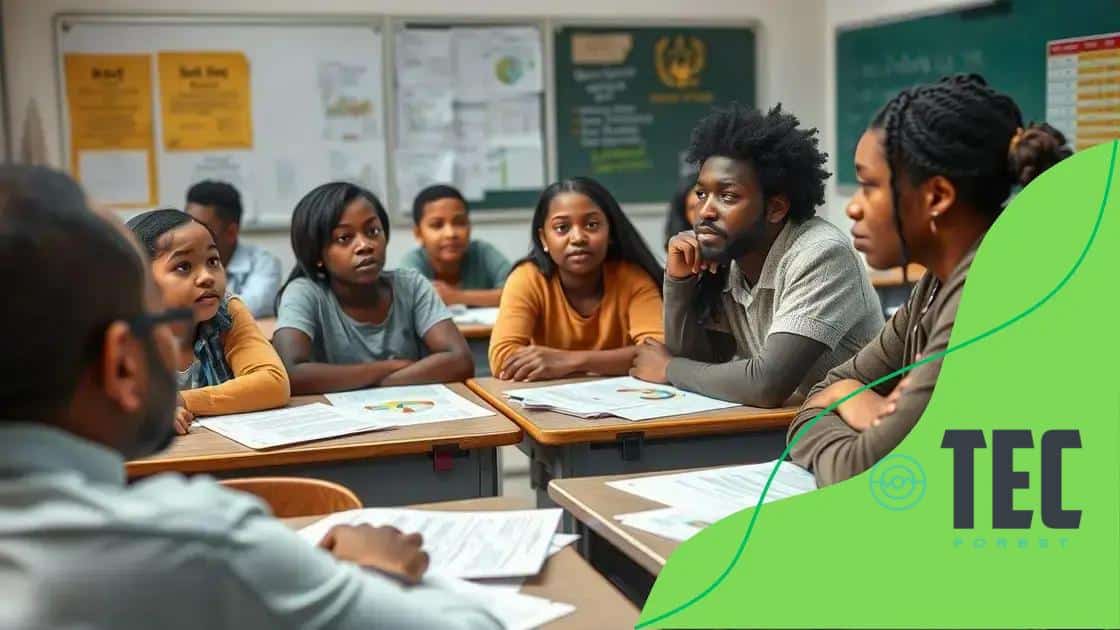Advertisement
Federal education changes raise concerns for minority students by creating barriers to resources, increasing disparities in academic support, and necessitating better advocacy from educators and families to ensure equitable educational outcomes.
Federal education changes raise concerns for minority students, as these shifts may deepen existing inequalities in access to quality education. What do these changes mean for your community, and how can we address potential pitfalls?
Advertisement
Understanding the implications of federal education changes
Understanding the implications of federal education changes is crucial as they affect students, teachers, and communities in several ways. These changes can reshape the educational landscape, particularly for minority students. It’s essential to examine the various aspects of these shifts to fully grasp their impact.
Key Impacts on Accessibility
One major area of concern is accessibility. School funding policies may shift, leading to *unequal* resources across districts. This could particularly affect schools in lower-income areas, where many minority students are enrolled.
Advertisement
- Potential decrease in federal funding
- Resource allocation disparities
- Impact on school infrastructure
- Limited access to advanced coursework
As resources become limited, students may find it harder to access essential educational tools. For instance, technology integration in classrooms can be compromised, adversely affecting students’ learning experiences.
Changes in Curriculum Standards
An additional concern involves changes in curriculum standards that may arise from federal education alterations. New requirements could either enhance or limit educational outcomes for students. In many cases, these changes do not account for the diverse needs of minority students.
- Increased focus on standardized testing
- Potential neglect of culturally relevant materials
- Variability in educational quality
Such shifts may leave minority students at a disadvantage, as they might not see their cultures represented in the curriculum. This absence can affect students’ motivation and engagement in their education.
Moreover, teachers must adapt to these changes quickly, often without adequate training or resources. This can lead to stress and burnout among educators, which further impacts their ability to support minority students effectively.
Challenges faced by minority students under new policies

Minority students often face unique challenges under new educational policies that stem from federal education changes. These policies can create barriers that hinder their academic success and overall experience in school.
Increased Barriers to Resources
One significant challenge is the increased barriers to accessing educational resources. As funding shifts, schools in underprivileged areas typically see cuts, affecting the availability of crucial tools.
- Limited access to technology
- Fewer extracurricular programs
- Reduced availability of advanced placement courses
Without these resources, minority students may not receive the same quality of education as their peers, impacting their long-term academic goals.
Disparities in Academic Support
Another key issue is the disparity in academic support. Minority students often have different educational needs, yet new policies may not provide adequate support systems. When schools lack resources, teachers may struggle to meet these diverse needs.
- Insufficient tutoring programs
- Inadequate counseling services
- Overloaded classroom sizes
This lack of personalized attention can significantly affect their performance and self-esteem, making it even harder for them to succeed academically.
Furthermore, the emotional impact of these changes cannot be overlooked. Minority students may feel marginalized and unsupported, leading to increased feelings of alienation from the school community. This emotional toll can manifest in various ways, affecting their motivation to engage in learning.
Strategies for advocacy and support for affected students
Strategies for advocacy and support for affected students are essential in addressing the challenges posed by federal education changes. Understanding what these students need can help create a more equitable learning environment.
Building Support Networks
One crucial strategy is building strong support networks. Schools, communities, and families should work together to provide resources and encouragement. When these groups collaborate, students benefit from various perspectives and support systems.
- Engaging with local community organizations
- Creating mentorship programs
- Establishing parent-teacher associations
By building these connections, minority students gain access to additional resources that can help them navigate their educational journeys.
Promoting Awareness and Education
Another important strategy involves promoting awareness about the issues these students face. Educating school staff and the community about minority students’ needs is vital. Workshops and training sessions can help foster understanding and empathy.
- Conducting professional development for teachers
- Organizing community awareness campaigns
- Distributing educational materials
When teachers and community members understand the specific challenges faced by minority students, they are better equipped to support them.
In addition to promoting awareness, it is crucial to empower students and their families. Providing them with tools and resources can help them advocate for their needs effectively. This includes sharing information about their rights and available services.
Furthermore, engaging students in advocacy initiatives allows them to express their concerns and desires. By involving them in discussions around policy changes, they can become proactive participants in shaping their educational experiences.
The role of educators in navigating these changes

The role of educators in navigating these changes is vital as they are on the front lines of implementing federal education changes. Teachers and school staff must understand how these changes impact their students, particularly minority students.
Understanding Policy Implications
Educators need to grasp the implications of new policies. This includes knowing how funding changes affect classroom resources. When teachers are informed, they can better advocate for their students’ needs.
- Staying updated on policy changes
- Participating in professional development workshops
- Collaborating with administration to align resources
Being aware allows educators to create an inclusive environment where all students can thrive.
Supporting Diverse Learning Needs
As classrooms become more diverse, educators play a crucial role in addressing varying learning styles and needs. It’s important for teachers to recognize that minority students may require different types of support.
- Implementing culturally relevant teaching practices
- Creating accessible learning materials
- Offering personalized feedback and support
When teachers acknowledge these diverse needs, they can help reduce gaps in academic achievement and ensure everyone has the chance to succeed.
Furthermore, fostering a safe and welcoming environment is essential. Creating strong relationships with students can lead to better academic outcomes. Educators must encourage open communication and be accessible for help.
Collaborating with families and communities is also a key aspect of an educator’s role. By engaging parents and community organizations, teachers can provide additional support and resources for their students.
Future outlook for minority students in education
The future outlook for minority students in education is influenced heavily by the changes in federal policies. As these shifts occur, it is important to consider how they will impact educational equity and opportunity for these students.
Potential Improvements in Policies
With a growing awareness of educational disparities, future policies may aim to create a more equitable learning environment. This could mean an increase in funding for schools that serve minority populations.
- Enhanced support for low-income students
- Investment in teacher training programs
- Emphasis on inclusive curriculum development
Such improvements can help bridge gaps in educational access and quality, fostering a better environment for minority students.
Technological Advancements
As technology advances, there is potential for innovative educational tools to enhance learning for minority students. Access to online resources can supplement classroom learning.
- Online tutoring programs
- Interactive learning platforms
- Virtual classrooms and collaboration tools
These advancements can provide students with personalized learning experiences, helping them stay engaged and succeed academically.
Moreover, the focus on community engagement can help ensure that minority students receive support both inside and outside the classroom. Building partnerships with local organizations can provide students with additional resources.
Engaging families in their children’s education is also crucial. When parents and guardians are involved, students tend to perform better academically. Schools can encourage parent involvement through workshops and programs that promote family engagement.
The future for minority students in education looks hopeful, but it requires effort from educators, policymakers, and communities. By advocating for supportive policies, embracing technology, and engaging families, we can create an environment where all students thrive. The focus on equity and inclusive practices can lead to better educational outcomes. Our collective efforts can pave the way for a brighter future for minority students.
FAQ – Frequently Asked Questions about Federal Education Changes and Minority Students
What are the main challenges faced by minority students under federal education changes?
Minority students may experience increased barriers to resources, disparities in academic support, and changes in curriculum that do not reflect their diverse backgrounds.
How can educators support minority students during these changes?
Educators can advocate for resources, implement inclusive teaching practices, and build strong relationships with students and their families.
What role does technology play in supporting minority students?
Technology can provide access to online resources, personalized learning experiences, and opportunities for collaboration that enhance educational equity.
How can families get involved in supporting their minority students’ education?
Families can engage by participating in school events, joining parent-teacher associations, and advocating for their children’s needs with educators.
